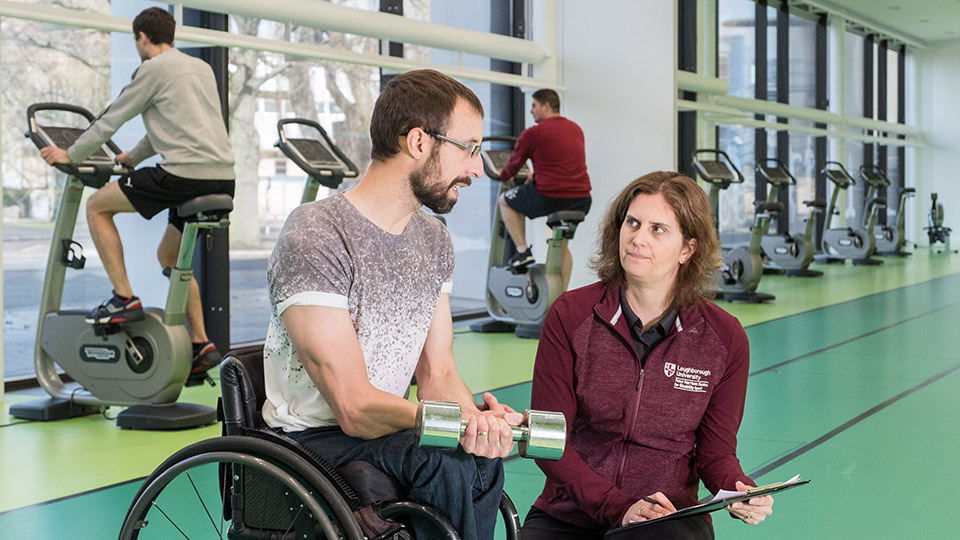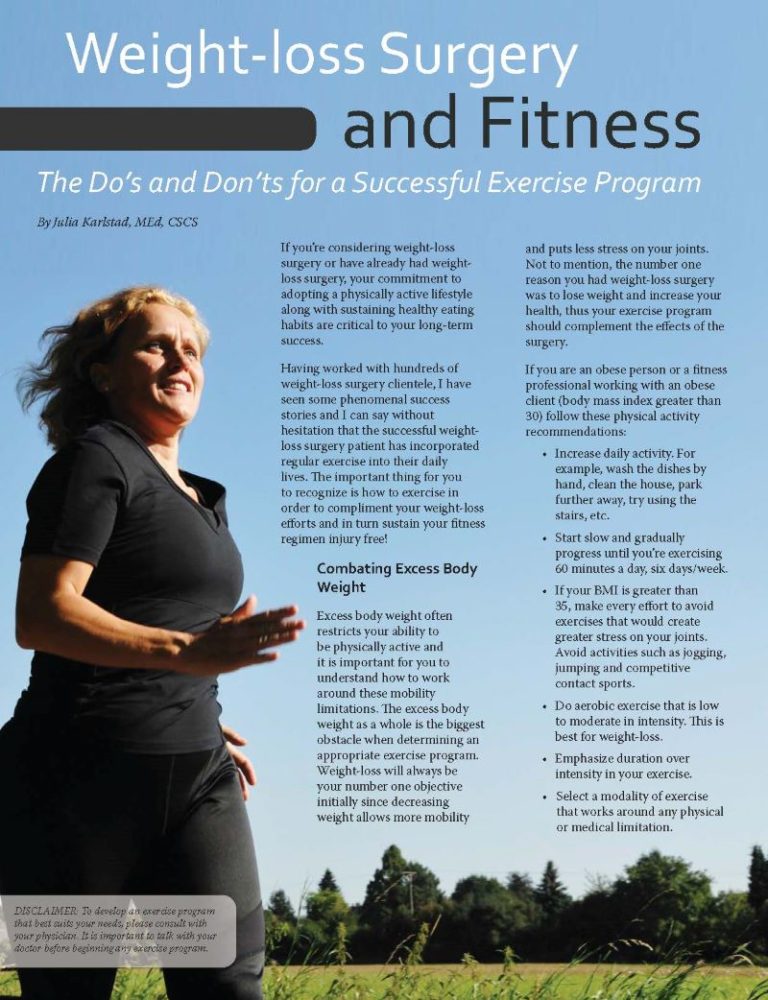Gentle exercises like swimming and stationary biking can aid weight loss for people with injuries. These activities minimize joint stress and promote healing.
Weight loss can be challenging, especially for individuals dealing with injuries. Engaging in low-impact exercises is crucial to avoid aggravating existing conditions while still burning calories. Swimming provides a full-body workout with minimal joint pressure, making it ideal for those with injuries.
Stationary biking offers a cardiovascular workout without the impact of running or jumping. Yoga and pilates can also help improve flexibility and strength without straining injured areas. Consulting with a healthcare professional before starting any exercise regimen ensures the chosen activities are safe and effective. These exercises help maintain fitness levels while promoting recovery and weight loss.
:max_bytes(150000):strip_icc()/3120777-GettyImages-1369113670-07faadeaebe743f2904c672d516f2e32.jpg)
Credit: www.verywellfit.com
Safe Exercise Options
Weight loss can be challenging, especially for those with injuries. Finding the right exercises is crucial. Safe exercise options can help you stay active without worsening your injury. These exercises focus on minimizing strain while maximizing benefits.
Low-impact Activities
Low-impact activities are excellent for people with injuries. They reduce stress on joints and muscles while promoting weight loss.
Here are some effective low-impact activities:
- Walking: Walking is gentle on the body and easy to do. Aim for 30 minutes a day.
- Elliptical Training: The elliptical machine provides a great cardio workout without heavy impact.
- Yoga: Yoga improves flexibility and strength. It also helps with relaxation and stress reduction.
- Stationary Biking: Cycling on a stationary bike offers a good cardio workout with minimal joint stress.
To compare these activities, refer to the table below:
| Activity | Calories Burned (30 mins) | Impact Level |
|---|---|---|
| Walking | 150-200 | Low |
| Elliptical Training | 250-300 | Low |
| Yoga | 100-150 | Low |
| Stationary Biking | 200-250 | Low |
Water Aerobics
Water aerobics is an excellent option for people with injuries. The water’s buoyancy reduces strain on your body.
Benefits of water aerobics include:
- Low Impact: Water supports your weight, reducing stress on joints and muscles.
- Full-Body Workout: Water resistance works all major muscle groups.
- Calorie Burn: A 30-minute session can burn 200-400 calories.
- Improved Flexibility: The water helps you move more freely, increasing flexibility.
Water aerobics can be done in various forms:
- Water Walking: Simply walk in the water for a gentle workout.
- Water Jogging: Jog in place or around the pool for a more intense session.
- Aqua Zumba: Dance-based exercise that is fun and effective.
- Resistance Training: Use water weights for strength training.
Here’s a quick comparison of water aerobics activities:
| Activity | Calories Burned (30 mins) | Intensity Level |
|---|---|---|
| Water Walking | 150-200 | Low |
| Water Jogging | 300-400 | Medium |
| Aqua Zumba | 250-350 | Medium |
| Resistance Training | 200-300 | Medium |

Credit: www.lboro.ac.uk
Strength Training Adaptations
Weight loss can be challenging, especially for people with injuries. It’s crucial to find exercises that help in losing weight without causing further harm. Strength training adaptations are essential for those dealing with injuries. These adaptations focus on building muscle and burning calories while minimizing injury risk.
Bodyweight Exercises
Bodyweight exercises are highly effective for people with injuries. They don’t require any special equipment and can be easily modified to suit your needs. The key is to perform these exercises with proper form to avoid strain.
Here are some bodyweight exercises that can aid in weight loss:
- Wall Sits: Great for strengthening the legs without putting pressure on the knees.
- Modified Push-Ups: Do these on your knees or against a wall to reduce strain on the shoulders.
- Seated Leg Raises: Sit on a chair and lift your legs to work on your core muscles.
- Chair Squats: Use a chair to guide your squats, ensuring you don’t go too low.
To keep track of your progress, consider maintaining a simple table:
| Exercise | Sets | Reps |
|---|---|---|
| Wall Sits | 3 | 15 seconds |
| Modified Push-Ups | 3 | 10 |
| Seated Leg Raises | 3 | 12 |
| Chair Squats | 3 | 15 |
Resistance Bands
Resistance bands are excellent for low-impact strength training. They are versatile and can be used for various exercises. They provide resistance without putting undue stress on your joints.
Here are some exercises using resistance bands:
- Banded Leg Press: Sit and loop the band around your feet. Press your legs out to straighten them.
- Seated Row: Attach the band to a sturdy object. Pull the band towards you to work on your back muscles.
- Bicep Curls: Stand on the band and pull it up with your hands to work on your arms.
- Band Pull-Aparts: Hold the band in front of you and pull it apart to strengthen your shoulders.
Tracking your exercises can be done using a table:
| Exercise | Sets | Reps |
|---|---|---|
| Banded Leg Press | 3 | 15 |
| Seated Row | 3 | 12 |
| Bicep Curls | 3 | 10 |
| Band Pull-Aparts | 3 | 15 |
Cardio For Injured Individuals
Weight loss can be challenging, especially for those with injuries. The good news is that there are effective cardio exercises that can help you shed pounds without straining your body. Cardio workouts are essential as they increase heart rate, burn calories, and improve overall fitness. Even with injuries, you can still achieve your weight loss goals by choosing the right cardio exercises.
Stationary Cycling
Stationary cycling is an excellent cardio option for injured individuals. It provides a low-impact workout, meaning less stress on your joints and injuries. Here are some benefits and tips for incorporating stationary cycling into your routine:
- Low Impact: Reduces the risk of further injury by minimizing pressure on knees and ankles.
- Adjustable Intensity: Allows you to control the resistance level, making it suitable for different fitness levels.
- Improves Cardiovascular Health: Strengthens your heart and lungs.
- Burns Calories: A 30-minute session can burn between 200-300 calories, aiding in weight loss.
To get the most out of your stationary cycling workouts, consider the following tips:
- Start with a warm-up to get your muscles ready.
- Gradually increase the resistance to challenge yourself.
- Maintain proper posture to avoid back strain.
- Incorporate interval training to boost calorie burn.
- Stay hydrated and take breaks if needed.
Elliptical Machines
Elliptical machines are another great choice for injured individuals. They offer a full-body workout while being gentle on your joints. Here are some reasons why ellipticals are beneficial:
- Low Impact: The smooth, gliding motion reduces joint stress.
- Full-Body Workout: Engages both upper and lower body muscles.
- Adjustable Resistance and Incline: Tailor the workout to your fitness level and goals.
- Burns Calories: Effective in burning calories, with a 30-minute session burning around 270-400 calories.
- Improves Balance and Coordination: Helps improve overall stability.
For an effective elliptical workout, keep these tips in mind:
- Begin with a gentle warm-up to prepare your muscles.
- Use the handlebars to engage your upper body.
- Mix up the resistance and incline for variety.
- Focus on maintaining a steady, rhythmic pace.
- Cool down and stretch after your workout to prevent stiffness.
Flexibility And Mobility Work
Weight loss exercises can be challenging for people with injuries. It’s important to focus on exercises that improve flexibility and mobility. These exercises help in reducing pain, improving range of motion, and making daily activities easier. Flexibility and mobility work is a gentle way to stay active and aid in weight loss without causing further injury.
Gentle Stretching
Gentle stretching is essential for people with injuries. It helps to keep the muscles flexible and reduces stiffness. Stretching can be done anywhere and requires no special equipment.
Here are some gentle stretches you can try:
- Neck Stretch: Slowly tilt your head towards one shoulder. Hold for 15 seconds. Repeat on the other side.
- Shoulder Stretch: Bring one arm across your body and hold it with the other arm. Hold for 15 seconds. Switch arms.
- Hamstring Stretch: Sit on the floor with one leg extended. Reach towards your toes. Hold for 15 seconds. Switch legs.
These stretches should be done in a slow and controlled manner. Never push yourself to the point of pain. It’s important to listen to your body and stop if you feel discomfort. Consistent stretching can lead to better flexibility and less pain.
Yoga Modifications
Yoga is a great way to improve flexibility and mobility. It combines stretching, strength training, and relaxation. For people with injuries, it’s important to modify yoga poses to avoid strain.
Here are some yoga modifications:
- Chair Yoga: Use a chair for support. This is great for those who have trouble getting up from the floor.
- Wall Yoga: Use a wall for balance and support. This helps in maintaining proper alignment.
- Props: Use yoga blocks, straps, and cushions to modify poses. These props help in reducing strain and making poses more accessible.
Yoga modifications allow you to enjoy the benefits of yoga without risking injury. It’s always a good idea to consult with a yoga instructor who is experienced in working with injuries. They can provide personalized modifications to suit your needs.
Consulting A Professional
Weight loss can be challenging, especially for those with injuries. Choosing the right exercises is crucial to avoid further harm. Consulting a professional ensures the safest and most effective approach to weight loss. This can include personal trainers and physical therapists who tailor programs to individual needs.
Personal Trainers
Personal trainers offer customized exercise plans for those with injuries. They assess your condition and design a program that avoids aggravating injuries. A good personal trainer will:
- Evaluate your injury
- Understand your weight loss goals
- Create a safe exercise plan
- Monitor your progress
Personal trainers focus on exercises that are low-impact yet effective. Common examples include:
- Swimming
- Walking
- Resistance band exercises
- Seated exercises
The table below highlights the benefits of these exercises:
| Exercise | Benefits |
|---|---|
| Swimming | Low-impact, full-body workout |
| Walking | Improves cardiovascular health |
| Resistance band exercises | Increases strength without strain |
| Seated exercises | Safe for lower body injuries |
Personal trainers ensure that exercises are performed correctly. This minimizes the risk of further injury. They also provide motivation, helping you stay committed to your weight loss journey.
Physical Therapists
Physical therapists are essential for those with severe injuries or chronic pain. They specialize in rehabilitation and safe exercise practices. A physical therapist will:
- Conduct a thorough assessment
- Develop a personalized exercise plan
- Provide hands-on treatment
- Adjust exercises as needed
Physical therapists use various techniques to aid weight loss without stressing the injury. These techniques include:
- Therapeutic exercises
- Manual therapy
- Electrical stimulation
- Hydrotherapy
The table below explains these techniques:
| Technique | Description |
|---|---|
| Therapeutic exercises | Exercises designed to improve strength and flexibility |
| Manual therapy | Hands-on techniques to reduce pain and improve mobility |
| Electrical stimulation | Uses electrical currents to reduce pain and improve muscle function |
| Hydrotherapy | Exercise performed in water to reduce impact on joints |
Physical therapists ensure exercises are safe and effective. This is crucial for those with injuries. They also provide ongoing support and adjustments to the exercise plan as needed. This helps in achieving weight loss goals safely.
Creating A Routine
Weight loss can be challenging, especially for people with injuries. It is crucial to create a routine that accommodates those injuries while still promoting health and fitness. This section will guide you through the process of creating a sustainable and effective weight loss exercise routine.
Setting Realistic Goals
Setting realistic goals is key to success. Having clear, achievable targets keeps you motivated and helps you avoid frustration. Start by assessing your current physical condition and understanding your limitations due to injuries.
Here are some steps to set realistic goals:
- Consult a healthcare professional: Always check with your doctor before starting any exercise routine. They can help you understand what exercises are safe.
- Start small: Begin with simple exercises that don’t strain your injury. Gradually increase the intensity as you build strength.
- Set short-term and long-term goals: Short-term goals keep you motivated. Long-term goals give you a vision to work towards.
Example Goals Table:
| Goal Type | Example |
|---|---|
| Short-term | Walk 10 minutes daily for a week |
| Long-term | Walk 30 minutes daily for a month |
Tracking Progress
Tracking your progress is essential to stay motivated and make necessary adjustments. It helps you see how far you’ve come and identify areas where you need improvement.
Ways to track your progress:
- Keep a journal: Write down your daily exercise routine, how you felt, and any pain experienced.
- Use apps: Fitness apps can track your activity levels, calories burned, and even your heart rate.
- Take measurements: Regularly measure your weight, waist size, and other relevant metrics.
Example Progress Tracking Table:
| Date | Activity | Duration | Notes |
|---|---|---|---|
| 01/01/2024 | Walking | 10 minutes | No pain |
| 02/01/2024 | Walking | 15 minutes | Slight knee discomfort |
Tracking progress keeps you accountable and helps you adjust your routine as needed. It also provides a sense of accomplishment as you meet your goals.
Nutrition And Recovery
Weight loss exercises for people with injuries can be a challenge, but proper nutrition and recovery play a vital role in achieving your goals. Focusing on what you eat and how you hydrate can make a significant difference. This section explores the importance of a balanced diet and hydration strategies to support your journey.
Balanced Diet
A balanced diet is essential for weight loss and recovery, especially if you have injuries. Proper nutrition helps your body heal faster and gives you the energy to stay active. Here are some key points to consider:
- Protein: Helps repair muscles and tissues. Include lean meats, fish, tofu, and legumes.
- Healthy Fats: Supports joint health. Add avocados, nuts, and olive oil to your meals.
- Complex Carbs: Provides sustained energy. Opt for whole grains, fruits, and vegetables.
It’s also important to avoid certain foods that can hinder your recovery:
- Sugary Snacks: Can cause inflammation and slow down healing.
- Processed Foods: Often high in unhealthy fats and sugars.
Here’s a simple table to guide your daily intake:
| Nutrient | Daily Recommendation |
|---|---|
| Protein | 50-60g |
| Healthy Fats | 20-30g |
| Complex Carbs | 200-300g |
Hydration Strategies
Proper hydration is crucial for weight loss and injury recovery. Water helps maintain your body’s temperature, removes waste, and lubricates your joints. Here are some effective hydration strategies:
- Drink Water Regularly: Aim for 8-10 glasses of water a day.
- Monitor Urine Color: Light yellow indicates good hydration.
- Include Electrolytes: Helps in muscle function. Use sports drinks or coconut water.
Dehydration can slow down your recovery process. Symptoms include:
- Dry mouth
- Fatigue
- Dizziness
If you have trouble remembering to drink water, try setting reminders on your phone or using a water bottle with time markers.
Here’s a simple hydration schedule:
| Time | Activity | Water (oz) |
|---|---|---|
| Morning | After waking up | 8 oz |
| Mid-Morning | Before exercise | 8 oz |
| Afternoon | With lunch | 8 oz |
| Evening | After exercise | 8 oz |
Staying hydrated and eating a balanced diet will help you recover faster and stay on track with your weight loss goals.

Credit: www.obesityaction.org
Staying Motivated
Weight loss exercises for people with injuries can be challenging. Staying motivated is crucial for success. Injuries may limit movement, but they shouldn’t hinder motivation. Let’s explore how to stay motivated through support groups and online communities.
Support Groups
Support groups offer a sense of community and understanding. They help you stay motivated by providing emotional support and practical advice. Here are some benefits of joining a support group:
- Shared Experiences: Connecting with others who face similar challenges can be comforting.
- Encouragement: Group members often cheer each other on, boosting morale.
- Accountability: Regular meetings can help you stay on track with your goals.
- Resource Sharing: Members share tips on exercises and techniques that have worked for them.
Support groups can be found in various places:
| Location | Description |
|---|---|
| Local Community Centers | Often host fitness and rehab support groups. |
| Hospitals | Run specialized groups for injury recovery. |
| Gyms | May offer classes tailored for injury recovery. |
Finding the right support group can be a game-changer. It can provide the push you need to stay committed to your weight loss journey.
Online Communities
Online communities are another excellent resource for staying motivated. They offer flexibility, diverse perspectives, and a wealth of information. Here’s why online communities can be beneficial:
- Accessibility: You can access them anytime, anywhere.
- Variety: They cater to different needs, from injury-specific forums to general weight loss groups.
- Expert Advice: Many communities have fitness experts who offer advice.
- Interactive Tools: Online communities often feature tools like progress trackers and workout plans.
Some popular online communities include:
| Website | Features |
|---|---|
| Various subreddits for injury recovery and weight loss. | |
| MyFitnessPal | Forums, progress tracking, and expert blogs. |
| Facebook Groups | Dedicated groups for different types of injuries and fitness levels. |
Joining an online community can make your weight loss journey less lonely. It connects you with others who understand your struggles and can offer valuable support.
Frequently Asked Questions
What Exercises Are Safe For Injured People?
Low-impact exercises like swimming, cycling, and yoga are safe. These activities are gentle on joints and muscles. Always consult your doctor before starting any new exercise regimen.
Can You Lose Weight With An Injury?
Yes, you can lose weight with an injury. Focus on low-impact exercises and maintaining a healthy diet. Consistency is key for effective weight loss.
How Can Injured People Stay Active?
Injured people can stay active through modified exercises like chair workouts, resistance bands, and light stretching. Always listen to your body and avoid overexertion.
What Are The Benefits Of Low-impact Exercises?
Low-impact exercises reduce stress on joints and help in recovery. They improve cardiovascular health, flexibility, and muscle strength. They are ideal for injury management.
Conclusion
Finding the right weight loss exercises with injuries can be challenging. Focus on low-impact activities that suit your condition. Always consult a healthcare professional before starting any new exercise regime. With patience and consistency, you can achieve your weight loss goals while ensuring your safety and well-being.









